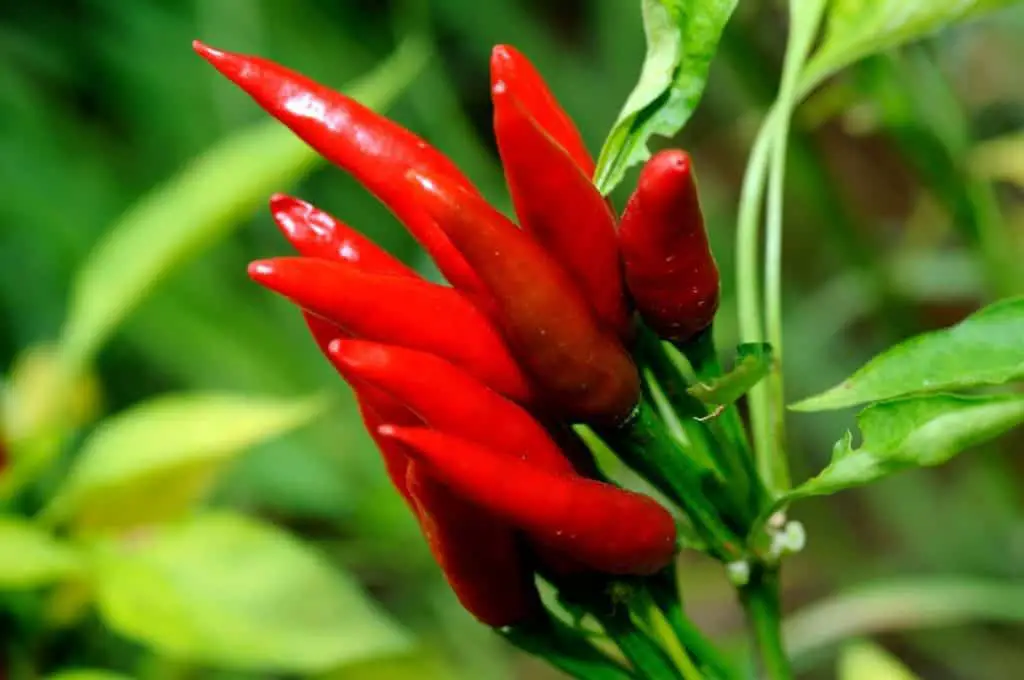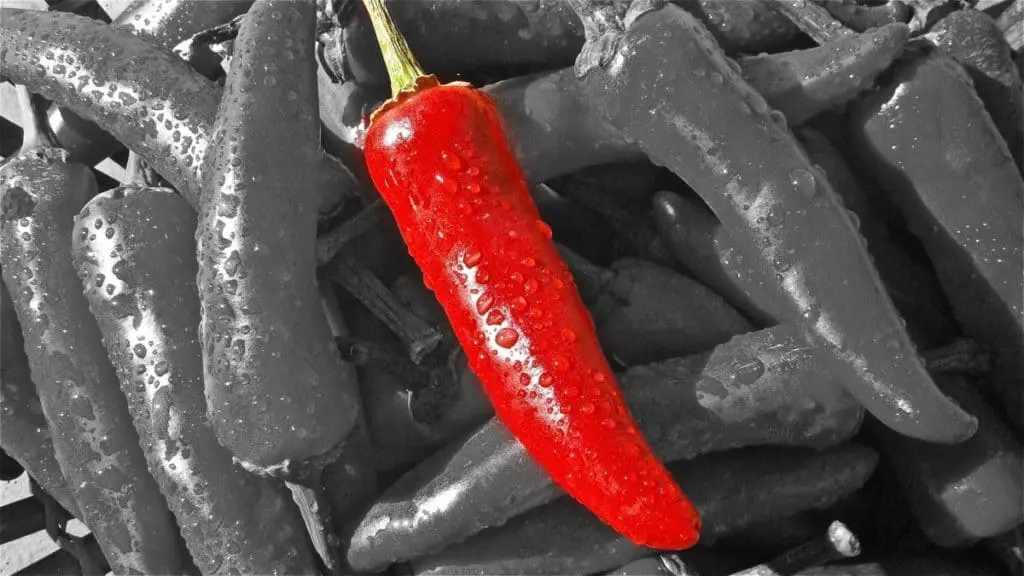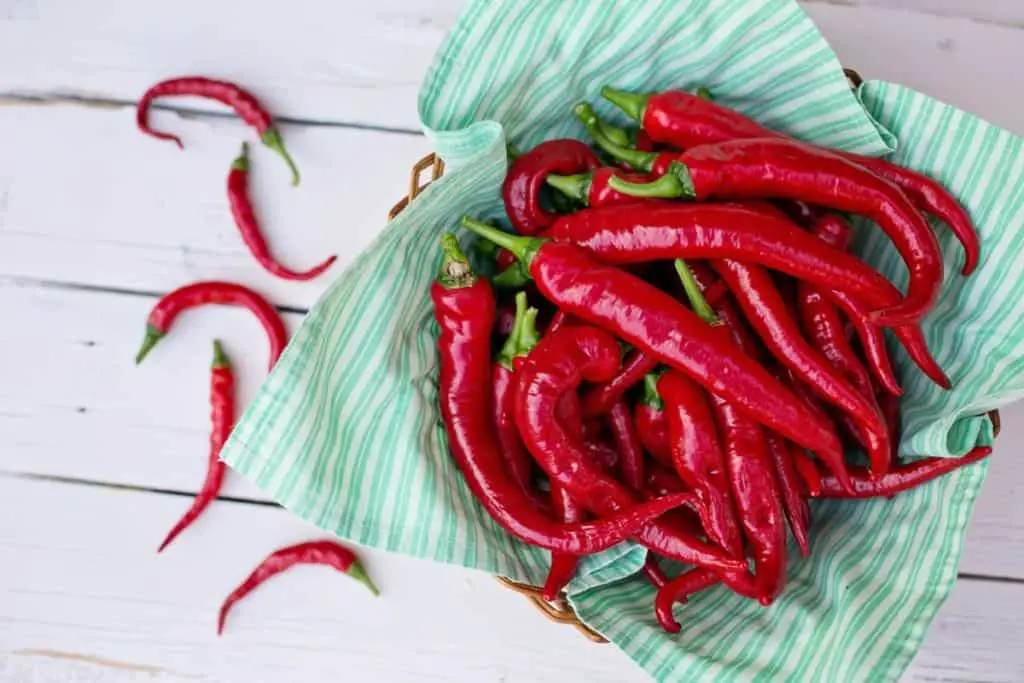Whether you buy your peppers at the grocery store or grow them in your own garden choosing the right pepper for your family is not an easy task. There are thousands of varieties of peppers and each one has its own heat signature.
Many peppers are not hot at all, but most will challenge even the most stalwart. Hot peppers are categorized on a scale named after American pharmacist William Scoville. It is called the Scoville scale. His method was devised in 1912. Up until that time, there was no widely used method for the measuring of a pepper’s heat characteristics.

The actual heat of any pepper can vary greatly depending on several factors like environment, seed origin and other factors. For our purposes, we will use the highest Scoville unit rating for each pepper, but all peppers can vary in heat.
#1) Coming in at a cool 0 to 100 Scoville unit is the bell pepper. Some favorite varieties are yellow bell and the California Bell. The bell pepper does not produce capsaicin which is the chemical in chili peppers that can cause a strong burning sensation when it comes in contact with mucous membranes.
#2) The Italian Sweet Pepper. Also coming in at 0 to 100 Scoville units it is a mild but tasty sweet pepper. Like many peppers, the Italian sweet starts its life green but turns from yellow to red when it’s mature.
#3) The Banana Pepper the banana pepper is a very mild 500 Scoville units also starting off green, the banana pepper will turn yellow which is the point most people will eat them they will also turn red when mature.
#4) The Poblano. Poblanos are very popular and widely grown in home gardens. They’re also palatable to most people at a milder 2,000 Scoville units.
#5) Is another popular pepper also at 2,000 Scoville units. It’s the Ancho However, the Ancho is just the dried version of the Poblano pepper. The Poblano is just ripened fully to a red color and then dried. They are commonly used in Mexican and southwestern cuisine.
#6) Is the Anaheim pepper with the rating of 2,500 on the Scoville scale, well, things are starting to heat up quite a bit. The Anaheim can be used fresh or dried

#7) The Cherry Bomb. They are about as close to circular as you’re going to see in the world of hot peppers, and they’re rather tiny. They are about two inches in total length, and Scoville rated these little buggers at about 5,000.
#8) Next, the beloved Jalapeno. Stuffed grilled or fresh the Jalapeno is one of America’s favorites. They can be a little fierce and come in at ten thousand Scoville units.
#9) Is the Hungarian Wax pepper. It may look like a mile Banana pepper but this pepper has a lot more bite. In terms of spiciness, it’s more akin to a Jalapeno and is used to top off a salad or even to pickle. It’s rated a searing 15,000 Scoville units.
#10) Is the Serrano. As Chili Peppers get smaller, they tend to get hotter, and Serranos will typically be about three times as hot as their Jalapeno cousin. They have a capsaicin rating of around 25,000. That’s about three times higher than the Jalapeno.
#11) The Fish Pepper has a unique look starting out green and cream striped moving on to orange with green to brown stripes and finally maturing to solid red. The peppers are an inch and a half to two inches long. It’s an heirloom variety and has a savage Scoville rating of 30,000.
#12) Is the Cayenne Pepper is a hot chili pepper used to flavor dishes. It is also sold whole or crushed as red pepper flakes. Cayenne peppers are generally sold dried. The majority of Cayenne chilies are used to make Cayenne Pepper Flakes. They rate a withering 45,000 on the Scoville chart.

#13) Is the Tabasco pepper it’s named after the Mexican state of Tabasco and is best known for its use in Tabasco sauce. The fruits are tapered and reach a length of about an inch and a half, and score an impressive fifty thousand Scoville units.
#14) Now there’s no single Thai pepper, though most peppers that claim that name are small in size, but high in heat. There are at least seventy nine separate varieties. The Thai pepper records a fiery 100,000 Scovilles.
#15) The Charleston Hot is a variety of cayenne that was created by the US Department of Agriculture in South Carolina. But that’s where the similarity ends the Charleston Hot has an impressive 100,000 Scoville units.
#16) Scotch Bonnets are brightly colored Jamaican hot chilies that are typically red or yellow. when fully ripe. But don’t let their pretty name fool you there are a blistering 350,000 Scoville units.
#17) Also registering a numbing 350,000 is the Habanero Chili. The Habanero starts its life in the garden green, and as they mature, they will take on an orange or red coloration.

#18) In 2007 the Guinness Book of World Records certified the Ghost Pepper as the hottest chili pepper on the planet. Ripe peppers are two and a half to three and a half inches long with a red yellow orange white purple or even chocolate color. They are an incredible 1,000,000 Scoville units.
#19) In August of 2013 Guinness World Records stated that Smokin’ Ed’s Carolina Reaper is officially the hottest chili pepper. The original cross was between two former world record holders, the Ghost pepper and a red Savina Habanero. It is to date the world’s hottest hybrid pepper this pepper scores an unimaginable 1.6 million to 2.2 million Scoville units.
#20) And last but not least is a new variety with a temporary name. Its temporary name is Pepper X. It is awaiting confirmation from Guinness that the pepper is actually hotter than the Carolina Reaper. Pepper X is a cultivar bred by Ed Curry creator of the Carolina Reaper.
Curry states that it is two times hotter than the Carolina Reaper, which would make it the hottest pepper in the world. With the Scoville rating of 3.18 million units. But this remains unconfirmed by the Guinness World Records as of mid-2019.
| Name | Scoville Heat Units |
| Bell Pepper | 0 – 100 |
| Italian Sweet Pepper | 0 – 100 |
| Banana Pepper | 500 |
| Poblano Pepper | 2000 |
| Ancho Pepper | 2000 |
| Anaheim Pepper | 2,500 |
| Cherry Bomb Pepper | 5,000 |
| Jalapeno Pepper | 10,000 |
| Hungarian Wax Pepper | 15,000 |
| Serrano Pepper | 25,000 |
| Fish Pepper | 30,000 |
| Cayenne Pepper | 45,000 |
| Tabasco Pepper | 50,000 |
| Thai Pepper | 100,000 |
| Charleston Hot Pepper | 100,000 |
| Scotch Bonnet Pepper | 350,000 |
| Habanero Pepper | 350,000 |
| Ghost Pepper | 1,000,000 |
| Carolina Reaper Pepper | 2,200,000 |
| Pepper X | 3,200,000 |
Bell Pepper Seeds (my Amazon affiliate link)
Italian Sweet Pepper Seeds (my Amazon affiliate link)
Banana Pepper Seeds (my Amazon affiliate link)
Poblano /Ancho Pepper Seeds (my Amazon affiliate link)
Anaheim Pepper Seeds (my Amazon affiliate link)
Cherry Bomb Pepper Seeds (my Amazon affiliate link)
Jalapeno Pepper Seeds (my Amazon affiliate link)
Hungarian Wax Pepper Seeds (my Amazon affiliate link)
Serrano Pepper Seeds (my Amazon affiliate link)
Fish Pepper Seeds (my Amazon affiliate link)
Cayenne Pepper Seeds (my Amazon affiliate link)
Tabasco Pepper Seeds (my Amazon affiliate link)
Thai Pepper Seeds (my Amazon affiliate link)
Charleston Hot Pepper Seeds (my Amazon affiliate link)
Scotch Bonnet Pepper Seeds (my Amazon affiliate link)
Habanero Pepper Seeds (my Amazon affiliate link)
Ghost Pepper Seeds (my Amazon affiliate link)
Carolina Reaper Pepper Seeds (my Amazon affiliate link)
Hopefully, you’re better informed now about pepper terminology and have learned enough about the heat ratings of some of the more popular peppers to keep yourself safe.
I know your time is valuable. I truly thank you for spending it here.
I have a YouTube Channel that has around 800 videos dealing with Homesteading, Gardening, and Emergency Preparedness. You can find them HERE.


